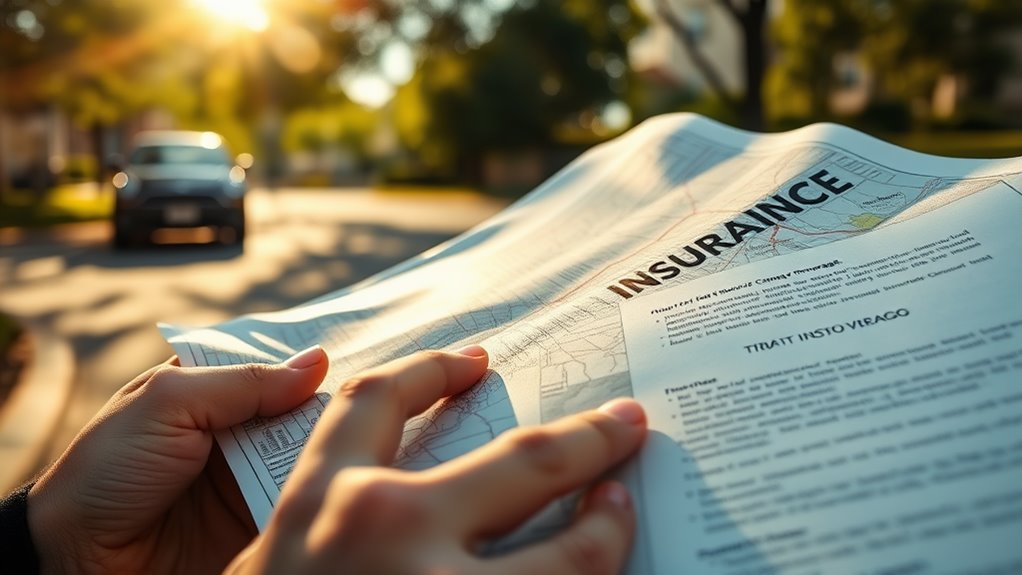Many new teen drivers don't realize that bundling insurance policies can lead to significant savings. By combining auto insurance with other types, you may access discounts that aren't widely advertised. Understanding how to navigate the complex world of insurance can make a big difference in your costs and coverage. So, what are the key strategies that can help you secure the best rates while ensuring you're well protected on the road?
Key Takeaways
- Consider bundling insurance policies to save between 5% and 25% on premiums while simplifying management.
- Look for student discounts, especially for those with good grades or attending school far from home.
- Choose a vehicle wisely; older models and those with safety features often come with lower insurance rates.
- Practice safe driving habits and complete defensive driving courses to qualify for additional discounts and improve skills.
- Monitor driving behavior with usage-based insurance programs to earn discounts for safe driving practices.
Understand the Benefits of Bundling Insurance Policies

When you're looking for ways to save on insurance, bundling policies can be a smart choice. By purchasing multiple policies from the same provider, like auto and homeowners or renters insurance, you often gain significant discounts. These discounts can range from 5% to 25%, with some companies offering savings as high as 20%. Bundling not only saves you money but simplifies your insurance management by reducing the number of bills and renewal dates you have to track. It also means dealing with one insurer for all your needs, making policy adjustments easier. Additionally, many insurers offer bundling discounts that can lead to considerable overall savings. In Michigan, understanding auto insurance requirements can also help you make informed decisions about your coverage. However, it's crucial to shop around, as not all companies offer the same bundling benefits. Always verify that bundling aligns with your coverage needs for maximum savings.
Explore Usage-Based Insurance Discounts
As you explore ways to save on insurance for your teen driver, consider the benefits of usage-based insurance (UBI). This innovative approach personalizes rates by monitoring driving behavior through telematics devices or smartphone apps.
By analyzing data on habits like mileage and speed, insurers can adjust premiums, often offering discounts of 10% to 15% for safe drivers. Programs like Allstate's Drivewise and Liberty Mutual's RightTrack are popular options.
UBI not only encourages safer driving but also allows parents to track their teen's habits. The potential for lower costs makes UBI an attractive choice, especially when combined with other discounts.
Choose the Right Vehicle for Lower Premiums
Choosing the right vehicle for your teen driver can considerably impact insurance premiums. Opting for a vehicle that balances safety, cost, and reliability can lead to significant savings.
Here are some key points to evaluate:
- Choose older models to lower premiums, as they're often less valuable and cheaper to repair.
- Look for safety features like airbags and stability control, which may qualify you for discounts.
- Avoid high-performance vehicles, as they generally come with higher insurance costs.
- Assess theft rates; some models are more likely to be stolen, increasing premiums.
- Select reputable makes like Honda or Toyota, known for lower insurance rates.
Take Advantage of Student Discounts

Taking advantage of student discounts can markedly reduce insurance costs for teen drivers. Many insurers offer significant savings for students under 25, especially those with good grades, typically a GPA of 3.0 or higher.
Student discounts can significantly lower insurance costs for teen drivers, especially for those maintaining a GPA of 3.0 or higher.
If you're attending school more than 100 miles from home, you might qualify for additional discounts. Full-time enrollment often opens these benefits, as does completing a safe driving program.
Discounts can range from 10% to 25%, depending on the provider. Remember to compare various insurance providers, like Allstate and State Farm, to maximize your savings.
Combining multiple discounts, such as good student and multi-vehicle discounts, can lead to even greater reductions in your premiums. Stay proactive to guarantee you're getting the best deal possible.
Prioritize Safety Features in Your Vehicle
While securing discounts can considerably lower insurance costs for teen drivers, the vehicle's safety features play a pivotal role in ensuring their well-being on the road.
Choosing a car equipped with advanced safety technologies not only enhances safety but can also lead to reduced insurance premiums.
When shopping for a vehicle, keep these key safety features in mind:
- Antilock brakes for better control during hard braking
- Forward collision warning to prevent accidents
- Lane-keeping assistance to help maintain lane discipline
- Blind-spot warning for increased awareness
- Automatic emergency braking for critical situations
Complete Defensive Driving Courses for Discounts
Completing a defensive driving course can greatly benefit teen drivers, not only by enhancing their skills but also by revealing insurance discounts. Many states mandate that insurance companies provide discounts for approved courses, which can save you up to 10% on your premiums.
These courses cover essential techniques like collision avoidance and hazard recognition, making you a safer driver. You can choose from online or in-person formats, depending on your preference.
To qualify for discounts, it's important to complete the course voluntarily, as court-ordered courses mightn't be eligible. Discounts can last for several years, so check with your insurer about the specific requirements and approved providers in your state to maximize your savings.
Maintain a Good GPA for Insurance Savings

A good GPA can be a game-changer for teen drivers looking to save on insurance costs. Many insurers offer discounts for students maintaining a GPA of 3.0 or higher, which can lead to savings of up to 30%.
Here are some key points to contemplate:
- Good student discounts usually require full-time enrollment for ages 16 to 25.
- Homeschooled teens can qualify through top scores on standardized tests like the SAT or ACT.
- Being on the "Dean's List" or "Honor Roll" can also grant discounts.
- Good grades reflect responsibility, potentially leading to safer driving habits.
- Continuous academic success can guarantee ongoing insurance savings throughout your schooling.
Maintaining a strong GPA isn't just about academics; it's a financial strategy too!
Adjust Your Deductible Wisely
When adjusting your deductible, it's vital to strike a balance between potential savings and financial risk. A deductible is the amount you pay out of pocket before your insurance kicks in.
Increasing your deductible from $500 to $1,000 can lower your premiums, but it also raises your out-of-pocket costs during claims. It's important to tailor your deductible to your budget and financial capability.
Assess your risk tolerance: a higher deductible means greater financial responsibility if an accident occurs. Consider creating a savings fund for potential claims to ease financial stress.
Gradually raising deductibles can help you find a comfortable balance between savings and risk, ensuring you're prepared for unexpected expenses on the road.
Review and Compare Insurance Policies Regularly
Reviewing and comparing insurance policies regularly can save you a significant amount of money and guarantee you have the right coverage as your circumstances change.
Staying informed about your options is key to finding the best deal and ensuring you're adequately protected.
- Regular Comparison Helps: Rates and offers can change frequently.
- Cost Savings: You might discover cheaper alternatives.
- Policy Adjustments: Adjust coverage as your age and grades change.
- Discount Options: Identify available discounts, like good student incentives.
- Customer Service Evaluation: Evaluate customer service through ratings and reviews.
Implement Safe Driving Practices to Reduce Risks
Implementing safe driving practices is essential for reducing risks on the road, especially for teen drivers who are still gaining experience.
Always wear your seatbelt, as it can cut serious injuries and deaths in half. Limit passengers to avoid distractions and maintain a safe following distance of at least three seconds. Stick to speed limits, as speeding is a major cause of accidents.
Avoid drowsy driving, which can impair your ability to react. Practice defensive driving by anticipating hazards and using turn signals. Keep your focus on driving, and don't let distractions like cellphones take your attention away.
Conclusion
In the world of teen driving, securing the best insurance doesn't have to feel like climbing a mountain. By bundling policies, choosing the right vehicle, and embracing safe driving habits, you can navigate the twists and turns with ease. Remember, maintaining good grades and exploring discounts can really lighten the load on your wallet. So, buckle up, stay informed, and enjoy the ride—your smart choices today pave the way for a smoother journey tomorrow!







